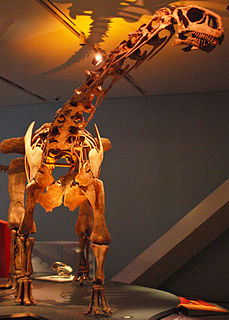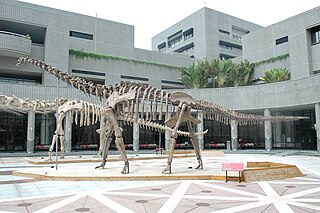
Malawisaurus was a genus of titanosaurian sauropod dinosaur. It lived in what is now Africa, specifically Malawi, during the Barremian-Aptian ages of the Early Cretaceous. It is one of the few titanosaurs for which skull material has been found.

Rebbachisaurus is a genus of sauropod dinosaur of the superfamily Diplodocoidea, that lived during the Late Cretaceous period in Africa about 99-97 million years ago. Remains attributed to Rebbachisaurus have been found in Morocco, Niger, Algeria and Tunisia, although only the Moroccan remains can be referred to the genus without doubt. The discovery of Rayososaurus, a South American sauropod nearly identical to Rebbachisaurus, supports the theory that there was still a land connection between Africa and South America during the Early Cretaceous, long after it was commonly thought the two continents had separated.

Adamantisaurus is a poorly-known genus of titanosaurian sauropod dinosaur from the Late Cretaceous Period of what is now South America. It is only known from six tail vertebrae but, as a sauropod, it can be assumed that this dinosaur was a very large animal with a long neck and tail.

Size is and has been one of the most fascinating aspects of dinosaur paleontology, to both the general public and professional scientists. Dinosaurs show some of the most extreme variations in size of any land animal group, ranging from tiny hummingbirds, which can weigh as little as three grams, to the extinct titanosaurs, which could weigh as much as 80 t.
Andesaurus is a genus of basal titanosaurian sauropod dinosaur which existed during the middle of the Cretaceous Period in South America. Like most sauropods, it would have had a small head on the end of a long neck and an equally long tail. Andesaurus was a very large animal, as were many others of its relatives, which included the largest animals ever to walk the Earth.
Hudiesaurus is a herbivorous sauropod genus of dinosaur from China. The fossil remains of Hudiesaurus were in 1993 found by a Chinese-Japanese expedition near Qiketai in Shanshan, Xinjiang province. The type species, Hudiesaurus sinojapanorum, was named and described by Dong Zhiming in 1997. The generic name is derived from Mandarin hudie, "butterfly" and refers to a flat butterfly-shaped process on the front base of the vertebral spine. The specific name refers to the members of the expedition but can also be read as "central part" in Chinese, a pun on the Japanese Chunichi Shinbun press group, which financed the research.

Futalognkosaurus is a genus of titanosaurian dinosaur. The herbivorous Futalognkosaurus lived approximately 87 million years ago in the Portezuelo Formation, in what is now Argentina, of the Coniacian stage of the late Cretaceous Period. The fish and fossilized leaf debris on the site, together with other dinosaur remains, suggest a warm tropical climate in Patagonia during this period.

Huanghetitan, is a genus of sauropod dinosaur from the early Cretaceous Period. It was a basal titanosauriform which lived in what is now Gansu, China.
Fusuisaurus is a genus of sauropod dinosaur from the Early Cretaceous of China. Fragmentary postcranial remains of this animal have been discovered in 2001 in the Napai Formation of Guangxi, China and consist of the left ilium, left pubis, anterior caudals, most of the dorsal ribs and distal end of the left femur. This sauropod has been described as a basal titanosauriform.

Daxiatitan is a genus of titanosaur sauropod dinosaur from the Lower Cretaceous of Lanzhou Basin, Gansu Province, northwestern China. It is known from fossils including several neck vertebrae, a shoulder blade, and a thigh bone.

Ruyangosaurus is a genus of titanosauriform sauropod dinosaur recovered from the Early Cretaceous Haoling Formation of China. The type species is R. giganteus, described in 2009 by Lü Junchang et al.

Qiaowanlong is a genus of sauropod dinosaur. Fossils belonging to the genus were found in 2007 from the Yujinzi Basin of Gansu, China, and were described in 2009 in the Proceedings of the Royal Society B. The remains come from a geological formation called the Xinminpu Group, dating to the Early Cretaceous about 100 Ma. The only known specimen consists of articulated cervical (neck) vertebrae and a right pelvic girdle, as well as several unidentified bone fragments. Qiaowanlong was initially reported as the first brachiosaurid to have been found from China. However, later analysis found that it was more closely related to titanosauriformes like Euhelopus and Erketu. It is estimated to have had a length of around 12 metres (39 ft) and would have weighed around 6 tonnes. The type species is Q. kangxii.
Barrosasaurus is a genus of titanosaurian sauropod dinosaur, first described by paleontologists Leonardo Salgado and Rodolfo Coria in 2009. The fossils, consisting of three fossil dorsal (back) vertebrae, are well-preserved but incomplete. They were discovered in the Anacleto Formation of the Neuquén province of western Argentina. The type species is Barrosasaurus casamiquelai. The genus name is named after the Sierra Barrosa in Neuquén. The specific epithet honours the Argentinian paleontologist Rodolfo Magín Casamiquela. It's been estimated to be 18 meters in length and 13.5 tonnes in weight.
The Haoling Formation is a Mesozoic geologic formation in the Ruyang Basin of Henan, Province, central China. Dinosaur remains are among the fossils that have been recovered from the formation.
Luoyanggia is a genus of oviraptorid dinosaur known from the Early Cretaceous Haoling Formation of the Ruyang Basin in Henan Province, central China. The type species is L. liudianensis. Holtz estimated it at 1.5 meters and around 2.27-9.1 kg. Molina-Pérez and Larramendi gave a similar size of 1.2 meters and 8.5 kg.

Xianshanosaurus is a genus of titanosaur sauropod dinosaur from the Early Cretaceous (Aptian-Albian) of the Ruyang Basin in Henan Province, China. It was described in 2009 by a team of Chinese paleontologists. The type species is X. shijiagouensis.
Rotundichnus is an ichnogenus of dinosaur footprint. Rotundichnus muchehagensis dates to the early lower Cretaceous in central Laurasia and the largest footprint, that was 87 cm (2.85 ft) long, belongs to an individual that measured 21.5 meters (70.5 ft) and weighed 36.5 tonnes.

Paralititan was a giant titanosaurian sauropod dinosaur genus discovered in coastal deposits in the Upper Cretaceous Bahariya Formation of Egypt. It lived between 99.6 and 93.5 million years ago.

Xinjiangtitan is an extinct genus of mamenchisaurid sauropod known from the Middle Jurassic Qiketai Formation in Piqan County of Xinjiang, northwestern China. Estimates of body length for the holotype are approximately 30–32 m (98–105 ft) in length, making Xinjiangtitan one of the longest sauropods known. In 2016 Gregory S. Paul gave a length of 30 meters and a weight of 40 tonnes. In 2020 Molina-Perez and Larramendi gave a lower estimation of 27 meters and 25 tonnes, with a total height of 17 meters making it one of the tallest known dinosaurs.

Notocolossus is a genus of titanosaurian sauropod dinosaur from late Cretaceous strata of Mendoza Province, Argentina.

























